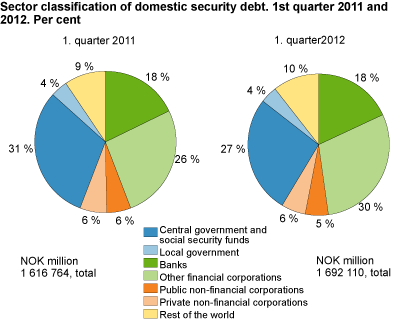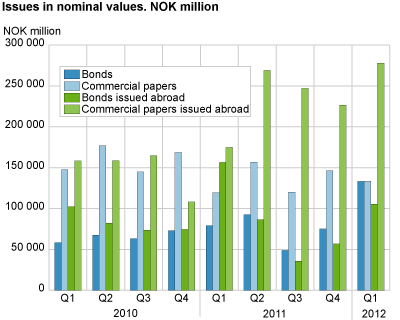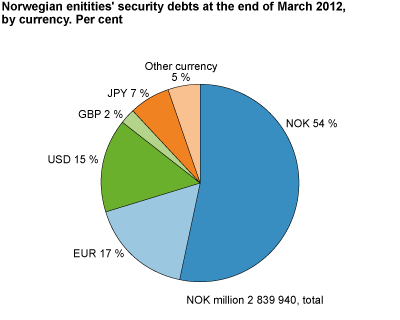Content
Published:
This is an archived release.
High volumes of issues and growth in debts
From the first quarter of 2011 to the end of March 2012, a relatively strong growth has been registered in Norwegian entities’ debts in Norway as well as abroad. Almost 50 per cent of the debts relate to issues abroad in foreign currencies.
In Norway, 267 issues of bonds and 287 issues of commercial papers valued at NOK 266.7 billion were registered during the first quarter of 2012. The share of values between bonds and commercial papers issued were about equal. Compared with the first quarter of 2011, the number and value of the issues rose by 39 per cent and 34 per cent respectively. Ninety-nine per cent of the issues in the first quarter of 2012 referred to issues by Norwegian entities. In the same period, Norwegian entities also issued 582 bonds and commercial papers valued at NOK 383.2 billion abroad. Compared with the first quarter last year, the number of such issues was reduced by 5 per cent, but the value of the issues rose by 13 per cent.
Institutional sector classification 2012The institutional sector classification has been revised. New four-digit sector codes have been introduced and the definitions of some sectors in the classification have been changed. The revised sector classification will be implemented in the Norwegian statistical system over the next two years. The new institutional sector classification has been introduced in the statistics for bonds and commercial papers from January 2012. One significant consequence of the new sector classification is introduction of new sectors for non-financial and financial corporations. Inter alia investment and finance companies and private equity funds that were previously classed as non-financial companies are now defined as financial institutions. This has led to a moderate growth of 'Financial corporations'. The new order of sectors is according to the international standard. Impact on statisticsThe introduction of a new sector standard has led to a shift in time series belonging to the statistics. New tables have been added that include time series from the first quarter of 2012 and onwards. Figures for January, February and March 2012 have been added to old "StatBank" tables with three-digit sector codes, but these will not be further updated.
The new sector classification led to few significant changes compared with the old classification in the values by groups of borrowers in the first quarter of 2012, except for the values of debts caused by bonds issued in Norway. Private non-financial incorporated enterprises' debt caused by bonds issued in Norway was 5 per cent below the level of debt caused by the old classification, while the debt value of 'other financial corporations than banks and mortgage companies' increased by 33 per cent.
|
Still large amounts of issues in Norway caused by rollover arrangements
In the first quarter of 2012, 43 per cent of the volume of issues in Norway; NOK 116.2 billion, referred to the central government. The second largest part of the issues; NOK 34.1 billion, referred to ‘other financial corporations’. A considerable part of these issues has been caused by ‘rollovers’/swap arrangements in which new treasury bills have replaced old treasury bills at their time of maturity.
Considerable issues by Norwegian banks abroad
The major part of the volume of issues by Norwegian entities abroad; 71 per cent (NOK 272.5 billion), referred to banks. The second largest part of the volume of such issues; NOK 75.8 billion, referred to ‘other financial corporations’.
Growth in outstanding debts abroad in foreign currency
The nominal value of outstanding bond and short-term security debts referring to issues in Norway amounted to NOK 1 692.1 billion at the end of March 2012. This is an increase of 5 per cent compared with the end of March 2011. The largest part of the debts, 30 per cent, referred to ‘other financial corporations’. The second largest part of the debts, 27 per cent, referred to the central government. The market value of the domestic bond debt was in general one per cent higher than the nominal value, while the market value of the domestic commercial paper debt was 0.3 per cent lower than the nominal value.
Ninety per cent of the debts in Norway at the end of March 2012; NOK 1 517.3 billion, referred to Norwegian borrowers. At the same time, Norwegian entities’ outstanding bond and short-term securities abroad amounted to NOK 1 323 billion; an increase of 13 per cent compared with the outstanding debt at the end of the first quarter of 2011. A major part of the debt in Norway is raised in NOK, while the major part of Norwegian entities’ debts abroad is raised in EUR, USD, GBP, JPY or, to some extent, in other currencies. A total of 38 per cent of Norwegian entities’ debts in Norway and abroad fall due within a period of two years.
Tables:
- Table 1 Gross issues of bonds and short-term securities. Number of issues and nominal value of issues in NOK million
- Table 2 Bonds issued in nominal value by borrowing sectors. NOK million
- Table 3 Bond debt in nominal value and market value, by borrowing sectors. NOK million
- Table 4 Commercial papers issued in nominal value, by borrowing sectors. NOK million
- Table 5 Commercial paper debt in nominal value and market value by borrowing sector. NOK million
- Table 6 Domestic bond and commercial papers debts by issuing sector and remaining maturity at the end of March 2012. Nominal value. NOK million
- Table 7 Norwegian entities' bonds and short-term securities debts abroad at the end of March 2012, by issuing sector and remaining maturity. Nominal value. NOK million
The statistics is now published as Securities.
Contact
-
Statistics Norway's Information Centre
E-mail: informasjon@ssb.no
tel.: (+47) 21 09 46 42



